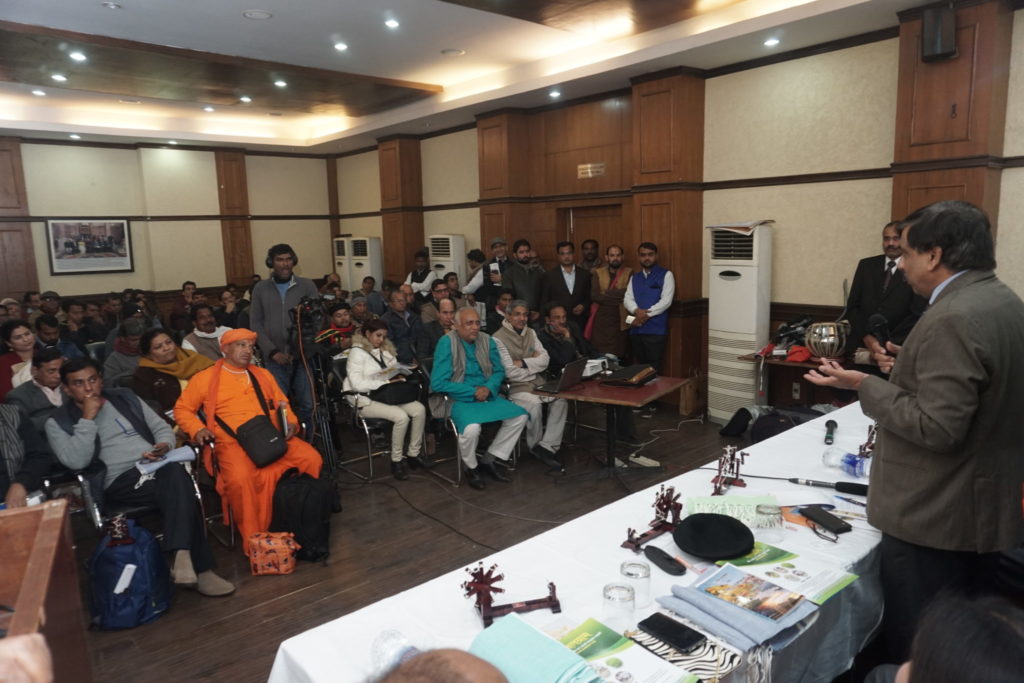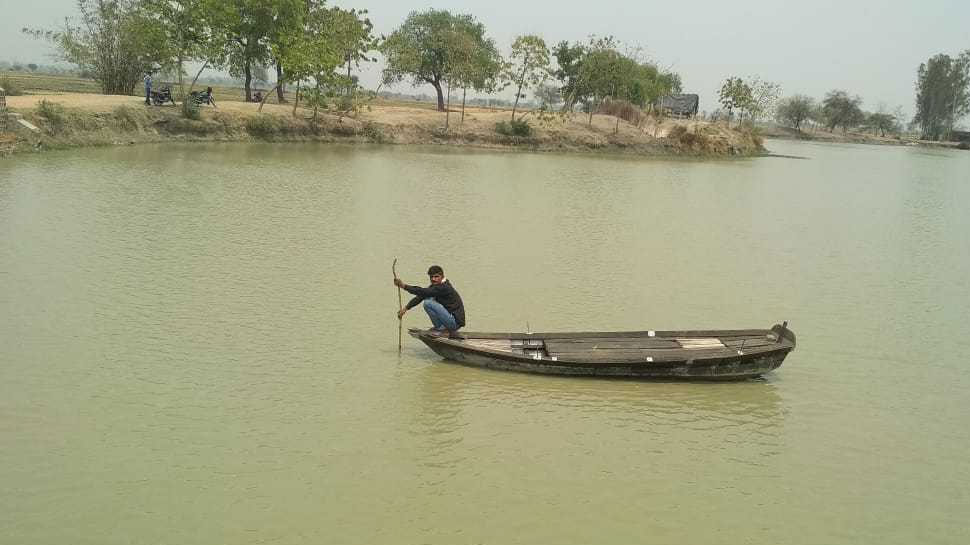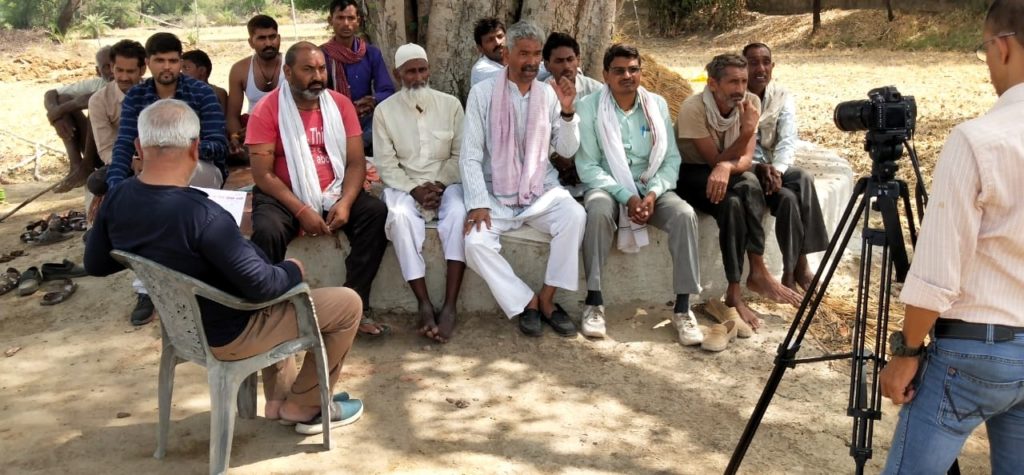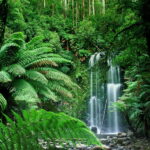
Jal Sankalp Anushathan by the people of Jakhani in Khajuraho
New Delhi / After presenting the glimpse of their achievements in the country’s capital Delhi, the people of jalgram Jakhani today announced to organize a festive-of-water titled ‘Jalaparva’ at the kala-tirtha Khajuraho, the heart of the country, on 14-15 March 2020. The village Jakhani has been declared as the model jalgram by NITI Aayog. On the footprints of Jakhani, Aayog has also announced to develop 1050 villages of the country which are facing water crisis. Jakhani, a village in Banda district of the drought-stricken region of Bundelkhand, has now become an example for the country. Agricultural scientists from India and abroad, including the developed countries like Israel, are coming to study the way Jakhani changed itself. In this village, once drought-hit, today the water-level has uplifted up to 20 feet from ground-level. At the same time, not only the 5 old ponds are at present brimmed with water but also new ponds have been dug― in these too, water has come after the rain. The population of this village situated in Mahua block, just 14 kilometer away from the district headquarter of Banda district, is close to 2562. Here, the agricultural land is about 2472 bighas. The village has 33 wells, 25 hand pumps and about six ponds. On the invitation of the Government of India, 10 representatives of jalgram Jakhani joined ‘Atal Groundwater Scheme’, a government-scheme-launching function held at Vigyan Bhawan in New Delhi on 25 December 2019. Prime Minister Narendra Modi in this event emphasized on that very traditional way of water-conservation, working on which the people of jalgram Jakhani have set an example.

People of Jalgram Jakhani in New Delhi
Addressing an event titled ‘The people of jalgram Jakhani in the country’s capital Delhi’ organized at the Press Club Auditorium in New Delhi on 19 December 2019, Upendra Pratap Singh, the Water Secretary of the Government of India, said that Jakhani had left-behind the bonds of dependency without any Government help. And “today for the whole world, Jakhani is a perfect example in the field of water-independence”, he said, “it is really the water-pilgrimage in famine-stricken Bundelkhand”. He advised: in order to prevent the falling of groundwater level, the Jakhani-model should be applied today in entire country. Not only the villages of India, but Israel too has accepted this experiment. All this is made possible due to Umashankar Pandey, a conscious and diligent farmer from of the village. No farmer will ever yearn for water, if every farmer of India becomes Umashankar.

“Jakhani did not depend on river water”, said Pramod Agrawal, the First Director of Ganga Action Program and the Former Principal Secretary of West Bengal, “it rather made rainy water held in big weirs in the fields and adjusted flow of it (rainy water) by efficient management to regenerate groundwater through natural resources like ponds and wells.” He gave credit to our sages and monks for elucidating this archaic method of collecting water. He further advised: we should explain this method of arrangement, which was explicated by our sages and monks, to the farmers of the whole country. Only this is the solution of water scarcity and falling groundwater level problem in today’s times.
Director of Agriculture and Technical University Banda, N. K. Bajpai, said during the program that the water collection as well as the application of agriculture in the entire country was very important. Additional Director General of Prasar Bharati, Rajasekhar Vyas, said that it was the need of the day to present the model of Jakhani loudly among the farmers through the media of the country. Nandkishore Agrawal, the President of Ekal Abhiyan that runs schools in almost one lakh villages, said that Ekal Abhiyan would teach about the model of Jakhani through education in the villages of the country. Former Secretary to the Government of India, Vishwapati Trivedi, said that Jakhani had set a great example in the direction of self-reliance by reviving India’s ancient water storage system.

Along with the message of NITI Aayog’s Adarsh Jalgram Jakhani coined as “Khet Par Med, Med Par Ped (Ridge in farm, Trees on ridge)”, Jalmitra-Anupam Samman was bestowed during this program. Tillan Richhariya, Director of the program, said that this program was also dedicated to Anupam Mishra Ji, a life-long warrior working for water resources and especially ponds. During this program, scholars working in different areas and Jalmitras (Friends of Water) hailing from different parts of the country were honored.
Umashankar Pandey, a purusharthi of village Jakhani in Mahua block, just 14 kilometers from Banda district of Uttar Pradesh’s Bundelkhand region, had taken a pledge 15 years ago with people from his village to revive the water bodies of the village without any government help and formed a Samiti (a Committee). Today this village, which is situated in such a region that has always been in news for drought and starvation, is an example of water self-sufficiency and surplus harvest from farm-fields. Economy of this village is an example not only for India, but also for the whole world on becoming self-dependent through its self-production model.
‘Sarvodaya Adarsh Jalgram Swaraj Abhiyan Samiti’, that was formed 15 years ago by a group of aware and determined people of the village under the leadership of social activist Umshankar Pandey of Jakhani, had started making people aware about the benefits of water-conservation, along with helping them make drains to flow the waste water of the village houses towards the farm-fields. When this water reached the fields, it was used for irrigation.

Water must be stored in the field where there is a ridge and where there is tree on the ridge
Umashankar Pandey, a social worker of Jakhani, says that we have not done anything new but have resurrected the old works. Quoting history, he says that when the Harbola farmers worked in Bundelkhand Region, they used to build a ridge on the field. They knew that if the water had to be retained in the field, it would stop only when there is a ridge. On the field where there will be a ridge, there will be a tree on the ridge, and water will be stored there. If water is retained, basmati rice will grow easily in it. People’s income will also rise and the groundwater level will also be uplifted. Today, the poorest farmer produces 50 thousand paddy in Jakhani village. One, who never had the money to repay the moneylender’s debt, today has one lakh Rupees of own in the bank. Here, a farmer with 3 Bigha (approximately 0.75 hectare) fields also has a tractor. Single harvester machine that is there in the entire Banda district, is owned by a farmer in this village, Mamun Khan.
In the region that is synonymous with various problems like migration of farmers to cities, starvation, poverty, illiteracy, water crisis throughout the year, and where even the Government is discussing that drinking water will be brought from Delhi to Bundelkhand by freight train, this village Jakhani in Banda district has shown what can be done without Government help through their model of 15-year collective and traditional effort of water-conservation and set an example before the country on how to solve such problems.
No grant was ever taken from the Government
In this collective effort for water-conservation, neither the government nor the new machine technology was used. The farmers, those unemployed and the youth of the village themselves raised the shovel and gave their time (shramdaan), made ridges, planted trees, retained water in the village, and made village rich in water-resources. And thus they made this village the first water-village (Jalgram) of the country and gave a model and inspiration to create 1050 water villages (Jalgrams) in the country.
Following are some of the organizations, academic institutes and government departments who have been conducting research and study on the model of jalgram Jakhani village and its people (farmers) to understand and learn better about collective efforts to conserve water and traditional water-conservation method:
# Water experts team of Israel Government,
# World Water Resource Group 2030,
# Agricultural Technology University Banda,
# Central Groundwater Board Uttar Pradesh,
Senior Officials of the Water Resources Department have taken note of the social and economic impact caused by Jakhani and how it has turned into a method of preventing migration of farmers. They have been spreading word and emulating this model around the country now for many years, doing further research on it, and looking at quoting Jakhani as a shining example in agriculture education.
Even though farmers in the village do not have any formal education, but their way of conserving water in a drought-stricken Bundelkhand region is a proof of being more educated than a university researcher above the methods of farming.
Organizing ‘Jalaparva’ in 2020 at the ‘Kala-tirtha Khajuraho’ will be an endeavor of the people of jalgram Jakhani to begin the campaign from where the work of jalgram Jakhani can be duly disclosed to the world. People can see here how a simple village Jakhani has became the Model Water-Village (Adarsh Jalgram) of NITI Aayog. Arrangements will be made from this venue to visit jalgram Jakhani where one will be able to see directly what the determined people of this village have done in these 15 years. Along with the special attraction of visiting Jakhani, there will be 4 sessions during the two-day event.
Following are the topics on which sessions are planned:
# Bechain Nadiyaan (Restless Rivers)
# Doobte Talab (Drowning Ponds)
# Ujadte Jangal (Desolating Forests)
# Jal-mitra Samman.






